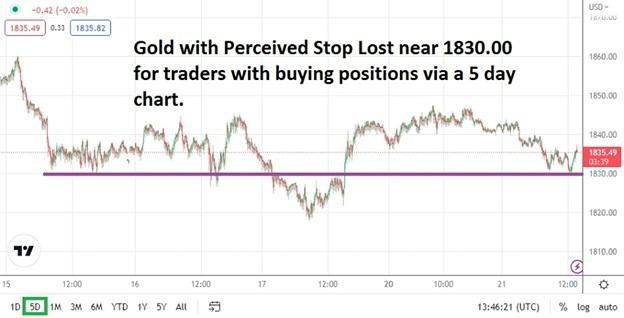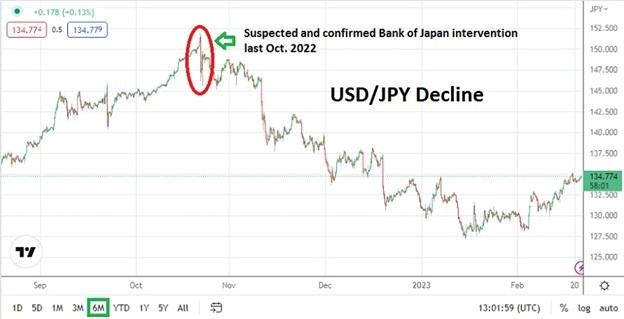(MENAFN- Daily Forex) Advertisement

Trade with a trusted,
award-winning broker. Get started! What is Stop Loss Hunting?
Stop loss hunting is the practise of deliberately pushing the price to a level where it will trigger stop orders.
'Stop loss hunting' is an often-heard expression about a real
market action, but sometimes used in an exaggerated manner by day traders when describing the price action of the market – particularly when things do not go their way.“They got my stop loss,” is an often-heard refrain. Stop loss hunting is a counterparty risk that exists but the reality is often more nuanced in financial markets. Many people need to understand stop loss hunting in a more precise manner to avoid its dangers and then apply the knowledge to trading strategy and in relation to risk managing open positions.
Not all market movements occur because of stop loss hunting, but it will certainly help traders to have an idea on its reasoning and mechanics. The practice of stop loss hunting and its evidence remains a matter of opinion many times as liquidity providers are obliged to provide tradable prices but not move them in a smooth incremental manner. Stop loss hunting is a lot like gravity, you cannot see it, but you know it is there.
Stop loss hunting 'blame' is focused primarily on the largest of financial institutions, including major brokers, dedicated market making liquidity providers and speculators. There is a wide complex list of reasons as to why a market is suddenly moved through a technical price level, but it is rarely intended to target an individual client with a stop loss order . Yes, large financial powers have enough cash to cause an imbalance in the marketplace momentarily push a market price to a level where they believe many stops will likely be placed by traders and therefore triggered by the move.
Stop loss hunting is undertaken to knock
active positions out of the marketplace and can weaken support and resistance levels which have established themselves as key resistance points. This may be done by market makers to generate profits, and also protect their active positions against trends that are developing. Forex and commodities are two of the more active asset classes
that are affected by stop loss hunting, but it also occurs in other assets too where there are derivatives allowing long and short positions.
Stop losses are used by many types of speculators big and small, including day traders to risk manage positions against going too far in the 'wrong' direction. If a day trader is using stop loss as protection to guard against a sudden reversal of trend, it is often chosen by using a technical indicator level which has seemingly displayed durable support or resistance within a certain timeframe.
The broad financial markets are awash with stop losses, and institutions via large brokerages are well aware of potential accumulation points - even without seeing the brokers order book they have a fair idea where client stop losses are likely to be placed. Brokerage firms that act as a market maker whom are caught with a trading position that is not balanced, meaning too much risk is on one side of the trade (either long or short), may have an incentive to eliminate positions to create financial safety for their institution. However, such thinking can generate unwarranted apprehension among small traders. Nonetheless, brokers with a significant institutional presence can theoretically undertake a stop loss hunting expedition, and some may resort to such practices when deemed necessary.

Forex Brokers We Recommend in Your Region See full brokers list 1
![brkr-logo]()
Read full review Get Started
Why Do You Need to Worry About Stop Loss Hunting?
Individual traders frequently express concerns about stop loss hunting and its potential negative impact on their active positions. in the Forex market open positions that are being traded and have accumulated near key numerical levels whether psychological or technical can become known targets through chart analysis.
For instance if stop losses are heavily concentrated at the level of ¥149 in the USD/JPY currency pair and the market is trading above ¥150, and is experiencing an active buying trend, a large institutional player such as the Bank of Japan could enter the market and initiate selling to drive down the value of the currency pair potentially. knocking out short positions with massive selling. The ability of large investment institutions to engage in such practices can generate fear among speculators, leading to reduced appetite for buyer the asset in the future.
Why would financial institutions use this as a strategy? Because it is large trading houses that often require a movement in the market that aligns with their chosen needs and outlooks. Stop loss hunting allows them to effectively create a vacuum in the market accelerating price movement in their intended direction. This allows them to capitalize on the momentum generated and achieve their intended price targets more efficiently. This tactic can help institutions manage their own risk exposure reducing the potential for large losses and preventing volatility form triggering a cascade of stop loss orders which could impact their own market positioning.
The interventions by the Bank of Japan in October 2022 to prevent pressure from buyers – whom it is suggested may have included brokerage houses and their larger traders - of the USD/JPY, created easier sailing for the BoJ and caused a steep selloff once speculative buyers were scared away.
Creating speculative fear by the Bank of Japan made selling the USD/JPY easier and helped deliver a stronger Japanese Yen. The BoJ selling intervention effectively stopped many speculators from stepping in quickly to buy, because they feared the central bank would intervene again.

Let's remember the
notional daily trading volume in Forex is nearly 5 trillion USD. Meaning. individual trades of most sizes are not actually targeted specifically, its more the collective sentiment that a large market maker is trying to influence. In other words a day trader with a position from 500,000 to even 1,000,000 USD in nominal trade size is not the critical target of stop loss hunters. A trader should not take the sudden gyrations of the Forex market personally, they should use the knowledge that stop loss hunting can and does take place as a way to understand and help them trade later on.
How Does Stop-loss Hunting Actually Happen?
By knocking out the large accumulated active positions via stop loss hunting in an asset, the large financial houses then have a freer hand to engage in their own activities.
Nearly all institutional trading today is being conducted by computers.
Trades are taking place within fractions of a second, measured in milliseconds or less via programmed algorithms targeting short term, mid-term and long-term values depending on certain trade signals. Financial houses are concerned about mid-level institutions with active positions, which are creating obstacles and are sometimes viewed as troublesome if they conflict with a market makers directional bias and need to be eliminated. This can include brokerages 'pooling' trades together for their clients.
Remember large financial houses use big cash positions in Forex and are not using leverage most of the time. Big trading houses have muscle and can move a market quickly; the size of their balance sheets mean their large positions can make the balance of an asset volatile – moving it in another direction quickly, while also being able to be patient because they have extremely deep pockets.
Potential Secrets via Options due to Hedging and Speculation
A hidden secret for day traders to use to tactically avoid stop loss hunting is using options pricing as a potential indicator. Options strike prices and trading volumes can show where options contracts are being bought and sold – via calls and puts. 'Near the money' options – contracts expiring soon and close to the spot price of the asset are potentially important information to consider regarding stop loss hunting.
These option reports are a legitimate method to gauge market sentiment. These prices can be interpreted as goals and protection, being used by institutional traders who may be hedging their bets in the spot markets.
Financial institutions placing large trades in the cash market know that they might have to hold a position due to a need of particular clients many of whom are not trading for speculative reasons – like corporations. The large financial houses often choose to trade options in the opposite direction of their cash positions as protection in case something goes against them; effectively hedging their exposure risk
Options can certainly be used to speculate, but they can also be used as protection – insurance would be another way of thinking about it. Knowing where options are being priced allows a day trader to have more information where large institutions are pricing in a potential for a market move, and therefore price levels where possible stop loss hunting may take place.
Price Data Sources are Used to Calculate Stop Loss Hunting Targets
Traders need to understand that large financial institutions gather clues like detectives to program their trading software. If the financial houses know where bias exists, they will use numerically analysis to quantify this data to create a small edge and try to decipher where other market participants have vulnerable market positions. The use of stop loss hunting knocks competitors out of the marketplace.
Gearing algos used by the financial institutions towards known bias in the marketplace due to expectations for government economic data releases and corporate outlooks is important. Financial houses are always trying to eliminate surprises in the marketplace and being caught on the wrong side of a big move; they are in the business of making money. They have a vast arsenal of information and quants whose task is to reduce operational risks in their trading models.
How to Avoid Stop Hunting by Setting a Proper Stop Loss?
Even fundamental traders, who disdain technical trading methods, should be aware that stop loss hunting can harm them. One way to fight against this is to know where psychological barriers and perceived important price levels exist via technical analysis and place their stop loss targets away from these key targeted values.
By creating a distant stop loss away from transactional activity, the likelihood of being able to stay in a trade longer exists for a speculator. However, this also means – because a wider stop loss is being used – that conservative amounts of leverage must be deployed to avoid over exposure in a single position.
If a wider stop loss is being used away from the 'known' target levels, this could indicate more value is being wagered than normal. Larger moves equate into larger amounts of money. A bigger reward for a potential trade also creates greater risk.
A Trading Strategy to Exploit Stop Loss Hunting
Another attractive consideration for speculators is to use perceived stop loss hunting terrain as a place to target their own take profit orders or initiate 'breakout' trades using momentum . Understanding where stop loss hunting targets are going to be generated, and having a belief that they will be aimed for by large financial houses, creates an opportunity to place a speculative trade using the institutions trading power as expectation prices will gravitate to these key levels.
By actively using a technical level which is viewed as a stop loss hunting ground, a trader can use take profit orders. A trader can also use a perceived stop loss hunting ratio as a location to enter a position, expecting a breakout due to developing momentum.
As a contrarian note, extremely aggressive and deep pocketed traders may tell you not to use stop losses, because this eliminates the ability to be knocked out of a trade. However, this is generally considered very dangerous because all your money can be wiped out on a single position if you are not using a stop loss. Only people that have absolutely no fear of destroying their trading account should consider this prospect. Without a stop loss, a speculator is risking all their money and even going into a negative balance is possible in some scenarios
Pros & Cons of a Stop Loss Hunting Trading Strategy
Stop loss hunting goes on in many Forex pairs and commodities. Pairs such as the GBP/USD, EUR/USD, USD/JPY, and the commodity Gold, do get the attention of large institutional traders who know where plenty of stop loss targets exist. This helps financial houses manage their business and often hurts smaller traders unaware of this factor.
However, knowing where stop loss hunting levels exists allows a trader to rest more comfortably in a market by avoiding these price levels, or deciding to stay out of a market when they feel too much accumulation is causing a massive amount of targeted trading
Understanding stop loss hunting also allows a trader who is more aggressive to enter a market using the momentum that often comes with key level breakouts. Using stop loss targets as a tool to use take profit orders, if a trader feels they know where momentum will occur or wants to enter new speculative positions is logical.
The main con of a stop loss hunting strategy as a retail trader is that, because you will not be able to see the clusters of stops, you will have to become very good at determining which support and resistance levels are likely to hold and which are likely to break. This aim might distract you from other profitable opportunities which arise from time to time in the market.
Bottom Line
Traders should be aware that stop loss hunting does go on. Large institutional trading houses use their sophisticated software and market analysis to target price level. Major financial houses seek to cause market action to benefit from the destruction of competing trades. Even market maker brokers sometimes do it to their own clients.
By being aware of stop loss hunting, a trader can protect themselves and stay away from dangerous price targets. The notion that markets become overbought and oversold creating stop loss hunting levels is real, and financial institutions will always work to protect their own value and avoid being on the wrong side of a significant market move.
Stop loss hunting is a common practice in the financial market, and traders who are aware of it can use it to their advantage. By understanding the dynamics of stop loss hunting, traders can make informed decisions on how to react to market movements. They can choose to be passive and avoid speculative positions or be aggressive and aim for the stop losses. Additionally, traders can use stop loss hunting as a price momentum indicator to forecast future price movements. Overall, stop loss hunting knowledge is an effective trading tactic for speculators in the financial market.
FAQs
Do brokers hunt stop losses? Yes, some brokers do hunt stop losses when possible, but they are most often reached because the market gravitates towards large clusters of stop losses, not because market maker brokers are hunting them.
Are stop loss orders a good idea? Yes, it is always a good idea to trade with a hard stop loss, to limit risk.
Are stop hunts real? Yes, some institutions do hunt large clusters of stop losses in the market.
Why do people stop loss hunt? People stop loss hunt to uncover more liquidity in the direction of the trade which they want in order to make profit. Trading into clusters of stop losses can be a profitable trading strategy if managed correctly.
Huzefa Hamid
I'm a trader and manage my own capital. I trade the major Forex pairs, some Futures contracts, and I rely entirely on Technical Analysis to place my trades. Today, I am also a Senior Analyst for DailyForex. I began trading the markets in the early 1990s, at the age of sixteen. I had a few hundred British pounds saved up (I grew up in England), with which I was able to open a small account with some help from my Dad. I started my trading journey by buying UK equities that I had read about in the business sections of newspapers. The 1990s were a bull market, so naturally, I made money. I was fortunate enough in my early twenties to have a friend that recommended a Technical Analysis course run by a British trader who emphasized raw chart analysis without indicators. Having this first-principles approach to charts influences how I trade to this day.
MENAFN15012024000131011023ID1107721932